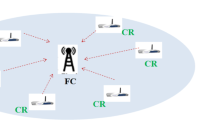Abstract
Arising issue of spectrum scarcity is resolved by emerging cognitive radio technology. In which, unoccupied portion of licensed spectrum would be granted for unlicensed user in order to upgrade the spectrum utilization. Spectrum sensing is an enabling task for labeling the spectrum holes and away from spectrum congestion in cognitive radio networks. Impact of secondary user’s cooperation developed cooperative spectrum sensing for effective spectrum sensing, many secondary users are to be associated in sensing the idle channels. Adversary secondary users (SU) mimic as primary user in cooperative sensing scheme, called primary user emulation attack (PUEA). If any SU forges the sensing data, that is known as spectrum sensing data falsification attack (SSDF). Rescuing the network against these two attacks is the major issue of cognitive radio networks. To address these challenges, we propose cognitive radio network to ensure security in cooperative spectrum sensing for video streaming application. Sensing based clustering algorithm assembles the cognitive radios into clusters to mitigate cooperative overhead and consumed energy. In order to avert PUEA attacks, we introduce authentication signature ID algorithm which provides authority for licensed user to use spectrum. To diminish SSDF attacks, we exploit Hamming algorithm to abolish forgery node from spectrum sensing decision. Furthermore PRN channel allocation algorithm is employed to precisely deliver the video with high quality and lower delay. For video transmission in cognitive radio network, we need to compress the video frames by block truncation coding-pattern fitting in order to reduce bandwidth consumption. This compression technique offers good video transmission with high compression ratio in cognitive radio network, due to trade-off among quality, bit rate and decoding time. Our proposed framework demonstrates the simulation with improved detection rate of idle channel and reduced the delay for high quality video transmission.












Similar content being viewed by others
References
Akyildiz, I. F., Lo, B. F., & Balakrishnan, R. (2011). Cooperative spectrum sensing in cognitive radio networks: A survey. Physical Communication, 4, 40–62.
Chandrashekar, S. (2013). Primary user authentication methods for mobile cognitive radio networks. Tucson: The University of Arizona.
Li, S. (2010). Channel allocation for smooth video delivery over cognitive radio networks. Waterloo, Ontario, Canada.
Delp, E., & Mitchell, O. (1979). Image compression using block truncation coding. IEEE Transactions on Communications, 27(9) 1335–1342.
Katre, A. D., & Desai, K. R. (2013). Cooperative spectrum sensing with weighted clustered architecture. International Journal of Scientific Engineering and Research (IJSER), 1(2). doi:www.ijser.in/archives/v1i2/SjIwMTM2.pdf.
Chen, T., Zhang, H., Maggio, G. M., & Chlamtac, I. (2007). CogMesh: A cluster-based cognitive radio network. IEEE.
Kyperountas, S., Correal, N., & Shi, Q. (2010). A comparison of fusion rules for cooperative spectrum sensing in fading channels. In Proceedings of the Wireless Symposium and Summer School , Blacksburg (pp. 2–4).
Das, D., Das, S. (2013). Primary user emulation attack in cognitive radio networks: A survey. IRACST-International Journal of Computer Networks and Wireless Communications, 3(3), 312–318.
Shah, H. A., Usman, M., & Koo, I. (2015). Bioinformatics-inspired quantized hard combination-based abnormality detection for cooperative spectrum sensing in cognitive radio networks. IEEE Sensors Journal, 15(4), 2324–2334.
Huang, X. L., Wang, G., Hu, F., & Kumar, S. (2011). Stability-capacity-adaptive routing for high mobility, multi-hop cognitive radio networks. IEEE Transactions on Vehicle Technology.
Author information
Authors and Affiliations
Corresponding author
Rights and permissions
About this article
Cite this article
Duggineni, C., Chari, K.M. Protection Against Defecting Attack and Enhanced Channel Allocation for Video Streaming in CRN. Wireless Pers Commun 97, 3215–3238 (2017). https://doi.org/10.1007/s11277-017-4671-8
Published:
Issue Date:
DOI: https://doi.org/10.1007/s11277-017-4671-8




